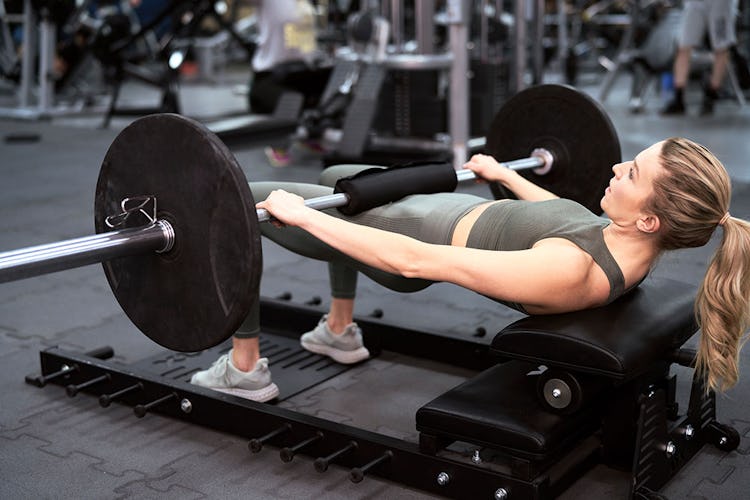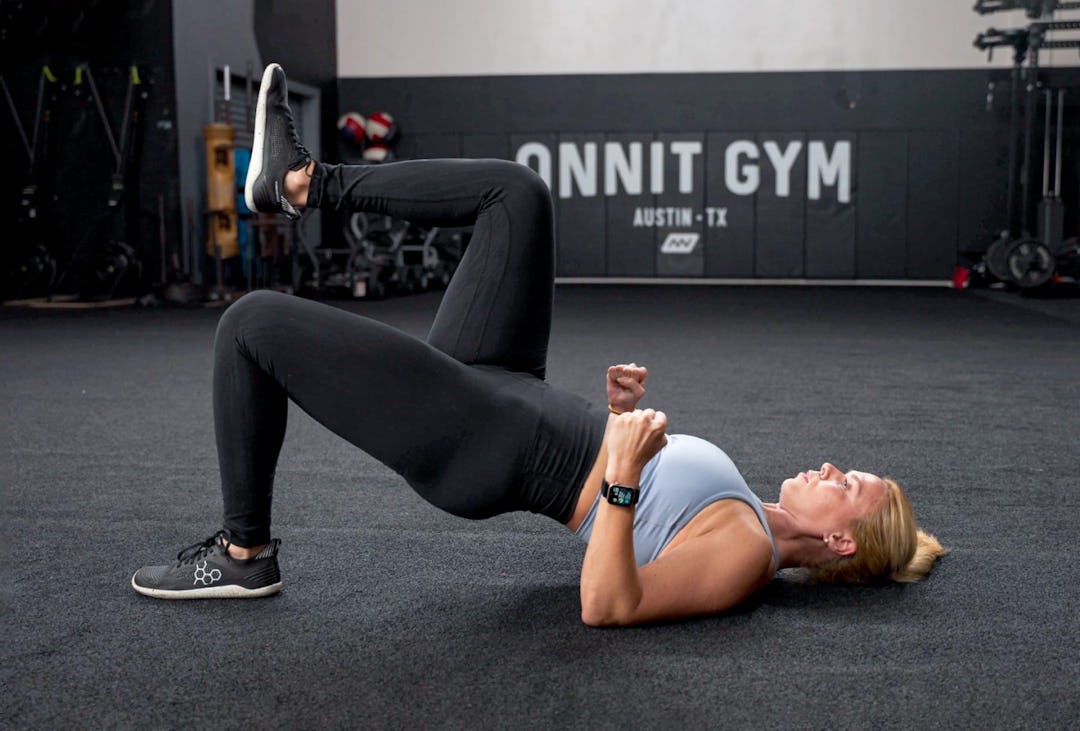The single-leg glute bridge is a progression of the two-legged glute bridge, where you lie on the floor and raise your hips up to full extension. Because the single-leg bridge works one leg at a time, it’s much more challenging than the basic glute bridge and requires a lot of stability through your hips and core. This makes it a great move for building functional strength and balance. Running, jumping, and most sports activities require you to stabilize your body and produce force on one leg at a time, and the single-leg glute bridge will train you to do that. It’s also good for improving range of motion in the hips, which can help relieve lower-back pain.
Keep scrolling, and you’ll learn how to perform the single-leg glute bridge correctly, when to use it, and what to do instead if you find it too challenging (or too easy).
What Is The Single-Leg Glute Bridge?
In any glute bridge exercise, you lie on your back on the floor and use your glutes to extend your hips. In the single-leg version, just one leg works at a time while the other is tucked near your chest. Supporting your bodyweight on one leg is very challenging—your hips will have a tendency to tilt, and your lower back may want to take over the movement to compensate for your glutes (if they’re weak). Therefore, the single-leg glute bridge is not a beginner’s movement. If you’re new to glute training, or bridging specifically, you should start with the two-legged version (and we’ll go over it below).
The single-leg glute bridge doesn’t offer as much range of motion as other glute exercises, such as the hip thrust or Romanian deadlift. It works the glutes in a more shortened position, focusing on the lockout of your hips to extension. For this reason, it serves as a nice complement to other glute exercises. It can also be a good option for when you’re traveling, or other times that you don’t have access to heavy weights or other gym equipment. For most people, their bodyweight alone makes for a challenging workout and will only allow them a handful of reps.
How To Properly Do A Single-Leg Glute Bridge
(See 00:44 in the video above.)
Step 1. Lie on your back on the floor and set up to do a regular, two-legged glute bridge. Place your feet flat on the floor close to your butt so your shins are nearly vertical. Tuck your chin toward your chest. Bend your elbows and make fists with both hands, actively driving your arms into the floor. This will help brace your upper body. At the same time, tighten your core, pulling your ribs down.
Step 2. Push through your feet to raise your hips up to full extension and squeeze your glutes as you come up. It’s important that you don’t hyperextend your lower back at the top of the movement, so keep your abs braced (think: “ribs down”) and focus on pushing your feet hard into the floor rather than trying to drive your hips up as high as possible.
Step 3. Lower your hips back to the floor with control.
Do a few practice reps and think about how it feels. If you feel the exercise more in your hamstrings than in your glutes, move your feet in a little bit closer to your butt. If you feel it more in your quads or knees, move your feet further away from you. You may also want to experiment with where your toes point and how wide your stance is. When you find a comfortable position where you feel like you’re balanced and working mostly glutes, you’re ready to do the exercise with a single leg.
Step 4. Raise one leg off the floor and bend that knee 90 degrees. “Your single-leg glute bridge stance should look like your standard glute bridge stance,” says David Otey, CSCS, a trainer, gym consultant, and fitness book author (OteyFitness.com). Some people like to keep the non-working leg extended straight from the hip, but Otey says this makes the exercise unnecessarily harder, turning it into more of a balancing act when you really just want to focus on glute bridging. So keep the non-working leg bent.
Step 5. Drive through the foot that’s flat on the floor to raise your hips up. Your shoulders, hips, and working knee should all move in alignment. Now control the way back down.
Many coaches suggest pushing through the heel of your foot as you bridge, and sometimes even letting your toes raise off the floor, but Otey recommends thinking of your foot as a tripod and pushing through the heel, ball, and pinkie toe knuckle. “To develop the glutes, hamstrings, and the rest of the posterior chain muscles in a way that will translate to your other activities,” says Otey, “your body has to learn to push with full foot contact. That gives you the most stability and activation. When you do athletic movements, you can’t sit on your heels, so learn to press through the ground.”
Otey also suggests wearing flat-soled shoes, or no footwear at all, to facilitate stable contact with the floor. “Fluffy shoes like running shoes or other types with a big heel or padding will make it harder,” says Otey.
You’ll immediately notice how much more unstable the single-leg bridge is than the double-leg, so be extra careful to drive with your elbows and keep your core braced. Your hips shouldn’t tilt or twist.
Aim to do as many reps as you can, which may be a lot or only a few. That makes the single-leg glute bridge both a good strength exercise to do if you don’t have weights as well as a good high-rep burnout exercise for the end of a lower-body workout.
What Muscles Do Single-Leg Glute Bridges Work?

The single-leg glute bridge works (surprise!) the glutes, but Otey notes that it engages the glute medius and minimus more than most other glute drills. These muscles act as stabilizers for the pelvis and keep the head of the femur in the hip socket.
Your back extensor muscles and core have to work as well to keep your pelvis level throughout the motion, and your upper back has to engage to prevent your torso from collapsing.
Further down the chain, the hamstrings, calves, and anterior tibialis (the muscle on the front of your shin) can’t help but get involved too.
Difference Between A Single-Leg Glute Bridge and A Regular Glute Bridge?
Again, the regular glute bridge is done with two feet on the floor while the single-leg bridge uses one leg at a time. Since it’s more stable, the regular glute bridge will allow you to add more external load (such as a barbell) when you’re ready to progress it, whereas the single-leg bridge requires more balance and may be challenging enough for you with bodyweight alone. Both exercises train the glutes, but the single-leg glute bridge is a more advanced progression, and the better choice for developing the smaller glute muscles that provide stability for everyday life activities like running and jumping.
“It’s important to do single-leg movements,” says Otey. “It benefits smaller muscle groups that support a limb when it’s working on its own. When you do bilateral [two-legged] exercises, it’s like doing a group project in school: one or two kids do all the work and the others coast. But when you do single-leg stuff, every muscle has to do its job or the movement will fail. If you force the body to use weaker muscles, it will use them, and make them stronger.”
Because of its benefits to balance, Otey says the single-leg glute bridge is good for kids as well as people in their 90s who are trying to stay active. It can also improve range of motion in the hips, which is helpful for relieving or preventing lower-back pain. The more your hips can move, the less the lower back will involve itself in various exercises, and that takes pressure off the spine.
Difference Between a Glute Bridge and a Hip Thrust?

The glute bridge and hip thrust are two distinct exercises that are often confused. Glute bridges are always done with the back on the floor, and that means their range of motion is fairly short. A hip thrust is done with the upper back supported on a bench (shown in the photo above), and that allows you to sink your hips to the floor and then extend them to the height of the bench. This takes the glutes through their full range of motion, so many coaches argue that the hip thrust is a better glute exercise for glute muscle gains than a glute bridge.
However, because the hip thrust’s range of motion is so wide, it does recruit some hamstring and quad muscle as well, and can be done to bias those areas even more depending on how you set it up. For those reasons, some coaches counter that the glute bridge is a better glute exercise, as it isolates the glutes to a greater degree.
The truth is, both the glute bridge and hip thrust should be done for complete, balanced glute development, and that includes their single-leg versions.
Kas Glute Bridge vs. Hip Thrust vs. Single-Leg Glute Bridge
The Kas glute bridge is yet another glute exercise that often gets spoken of interchangeably with hip thrusts and glute bridges, but it’s really a separate exercise entirely. Named for the coach who popularized it, Kassem Hanson, founder of N1, an online training education course, the Kas bridge is a hip thrust with a shortened range of motion. (If you’ve been paying attention, you know by now that the term “bridge” implies that you do it on the floor, but this is NOT the case with the Kas glute bridge.)
You set up on a bench (usually with a barbell in your lap) and start with your hips locked out; then lower your hips about a third of the way down to the floor (or until your knees start to drift backward), and lock out again. This keeps the tension of the exercise squarely on the glutes, rather than involving the hamstrings and quads, as the basic hip thrust does.
You can perform the same movement with one leg (a single-leg Kas glute bridge), but the single-leg bridge on the floor achieves mainly the same thing.
Single-Leg Glute Bridge Alternatives
(See 02:16 in the video.)
The single-leg glute bridge is a lot harder than the two-legged glute bridge, so if you find that you can’t bridge up all the way or keep your balance, take it down a notch with a simpler exercise. One option is the B-stance glute bridge, which uses your non-working leg like a kickstand, providing a little more stability but still allowing you to work one side of the hips at a time.
B-Stance Glute Bridge
(See 02:28 in the video.)
Step 1. Set up as you did for the single-leg glute bridge and slide your non-working leg forward until the heel of that foot is even with the toes of the working foot.
Step 2. Now bridge up as you did for the single-leg glute bridge. The heel of the non-working leg shouldn’t really push into the floor—it’s just there to help your balance. Try to keep most of your weight on your working leg when you bridge.
Glute March
(See 03:00 in the video.)
Another alternative to the single-leg glute bridge that’s a little easier is the glute march. Here, you’ll bridge up with both legs and, keeping your hips elevated, raise one leg at a time like you’re marching your feet. When you master this move, you should be able to do the single-leg glute bridge with no problem.
Bret Contreras, PhD, a coach and world-renowned expert on glute training (@bretcontreras1 on Instagram) uses glute marches as his preferred regression of the single-leg glute bridge. In his textbook, Glute Lab, a comprehensive guide to glute training, he says that he often has clients do this movement as a warmup before they attempt the single-leg glute bridge, performing 2 sets of 20 reps (10 on each leg).
Two-Up, One-Down Glute Bridge
(See 03:16 in the video.)
A third option is to bridge up with both legs and then raise one leg off the floor and lower your body back down with the other leg. This will help you build control in your hips and set you up for a full-range single-leg glute bridge down the line.
Progression: Single-Leg Hip Thrust
(See 03:52 in the video.)
When you feel like you’ve mastered the single-leg glute bridge, Otey recommends you try the single-leg hip thrust, which increases the range of motion by resting your shoulders on a bench.
Step 1. Rest your upper back on a bench with your body perpendicular. The bottom of your shoulder blades should line up with the edge of the bench. Place your feet in front of you and find your comfortable stance. Bend your elbows and dig your arms into the bench for stability, making fists with your hands. Raise one leg off the floor and bend that knee, bringing it toward your chest.
Step 2. Push your working foot into the floor and raise your hips until they’re roughly in line with your working knee and your shoulders.

)





